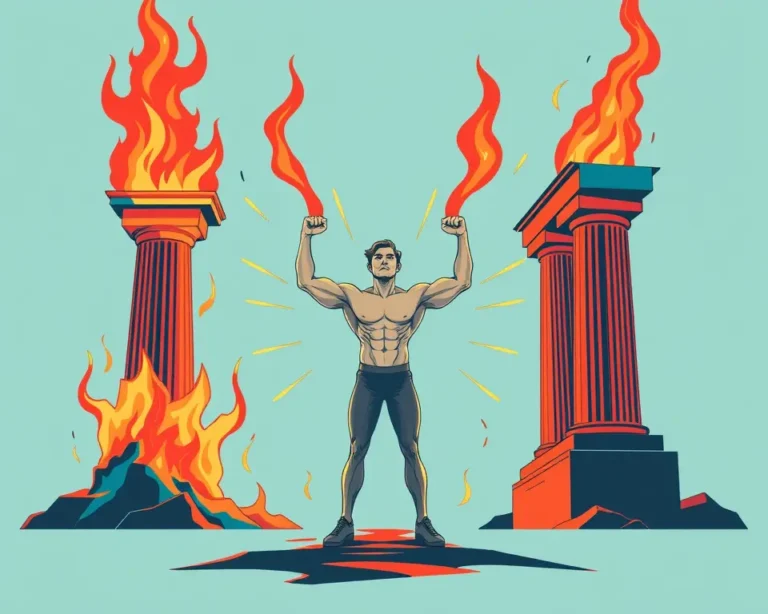The quest for a lean, toned physique often feels like navigating a minefield. You want to shed unwanted fat, but the fear of losing hard-earned muscle looms large. The good news? It’s entirely possible to achieve both simultaneously. This article unveils the diet “hack” – a strategic approach to nutrition and exercise – that will help you torch fat while preserving, and even building, lean muscle mass.
Understanding the Challenge: Why Fat Loss Can Mean Muscle Loss
Before diving into the solution, it’s crucial to understand the problem. When you restrict calories to lose weight, your body taps into its energy reserves. Ideally, it would exclusively burn fat. However, if the calorie deficit is too drastic or your diet lacks key nutrients, your body may also break down muscle tissue for fuel. This is because muscle is metabolically active; it requires energy to maintain. In a survival scenario (as your body might perceive a severe calorie restriction), muscle becomes a “luxury” that can be sacrificed.
The “Diet Hack”: A Multifaceted Approach
The secret to burning fat without losing muscle isn’t a single trick, but rather a combination of strategies working in synergy. Think of it as a holistic approach encompassing diet, exercise, and lifestyle adjustments.
1. Calorie Control: Finding the Sweet Spot
A calorie deficit is essential for fat loss – you need to burn more calories than you consume. However, the size of the deficit is critical.
- Avoid Extreme Restriction: Drastically cutting calories (e.g., very low-calorie diets) can lead to rapid weight loss, but a significant portion of that loss will likely be muscle.
- Aim for a Moderate Deficit: A deficit of 300-500 calories per day is generally recommended. This allows for steady fat loss (around 0.5 to 1 pound per week) while minimizing muscle breakdown.
- Track Your Intake: Use a food tracking app or journal to monitor your calorie consumption and ensure you’re within your target range.
- Listen to Your Body: Pay attention to hunger cues and energy levels. If you feel excessively fatigued or constantly hungry, you may need to adjust your calorie intake.
2. Protein Prioritization: The Muscle Preserver
Protein is the cornerstone of muscle maintenance and growth. It provides the amino acids your body needs to repair and rebuild muscle fibers, especially during periods of calorie restriction.
- Adequate Intake: Aim for a protein intake of 1.2 to 1.6 grams per kilogram of body weight (or approximately 0.8 to 1.0 grams per pound) daily. If you’re actively strength training, you may need to increase this slightly.
- Spread it Out: Distribute your protein intake evenly throughout the day, consuming 20-40 grams of protein every 3-4 hours. This ensures a consistent supply of amino acids for muscle protein synthesis.
- Prioritize Quality Sources: Choose lean protein sources such as:
- Chicken breast
- Turkey
- Lean beef
- Fish (salmon, tuna, cod)
- Eggs
- Low-fat dairy (Greek yogurt, cottage cheese)
- Plant-based options (tofu, lentils, beans, quinoa)
- Post-Workout Protein: Consume a serving of protein (20-40 grams) within two hours after exercise to stimulate muscle recovery and growth.
3. Strength Training: The Muscle Builder
While diet is crucial, exercise is equally important for preserving and building muscle during fat loss. Strength training, also known as resistance training, is the key.
- Stimulate Muscle Growth: Lifting weights signals to your body that it needs to maintain and build muscle mass.
- Frequency: Aim for at least two to three strength training sessions per week, targeting all major muscle groups (legs, back, chest, shoulders, arms).
- Progressive Overload: Gradually increase the weight, reps, or sets you lift over time to challenge your muscles and promote continued growth.
- Compound Exercises: Focus on compound exercises that work multiple muscle groups simultaneously, such as squats, deadlifts, bench presses, and rows.
- Proper Form: Prioritize proper form over lifting heavy weights to prevent injuries and ensure you’re effectively targeting the intended muscles.
4. Smart Cardio: Complement, Don’t Compete
Cardiovascular exercise is beneficial for overall health and can contribute to calorie expenditure, but excessive or intense cardio can hinder muscle growth.
- Moderate Intensity: Opt for moderate-intensity cardio activities like brisk walking, jogging, cycling, or swimming.
- Limit Duration: Keep cardio sessions to a reasonable length (30-60 minutes) to avoid excessive calorie burn and potential muscle loss.
- HIIT (High-Intensity Interval Training): Consider incorporating HIIT workouts, which involve short bursts of intense exercise followed by brief recovery periods. HIIT can be effective for fat burning without sacrificing muscle. However, be mindful of overdoing it.
- Listen to Your Body: Adjust the intensity and duration of your cardio workouts based on your energy levels and recovery capacity.
5. Nutrient Timing: Optimizing Fuel
When and what you eat can also play a role in preserving muscle and maximizing fat loss.
- Pre-Workout Nutrition: Consume a meal or snack containing carbohydrates and protein 1-2 hours before exercise to fuel your workout and provide your muscles with building blocks.
- Post-Workout Nutrition: As mentioned earlier, prioritize protein after exercise to stimulate muscle recovery and growth. You can also include some carbohydrates to replenish glycogen stores.
- Carb Cycling: Some people find carb cycling (varying carbohydrate intake on different days) helpful for optimizing fat loss and muscle preservation. This typically involves consuming more carbs on training days and fewer carbs on rest days.
- Don’t Fear Carbs: Complex carbohydrates, such as whole grains, fruits, and vegetables, are essential for energy and muscle recovery. Don’t eliminate them entirely from your diet.
6. Hydration: The Unsung Hero
Water is crucial for virtually every bodily function, including muscle function and fat metabolism.
- Stay Hydrated: Drink plenty of water throughout the day, especially before, during, and after exercise.
- Electrolyte Balance: Replenish electrolytes lost through sweat, especially during intense workouts. Sports drinks or electrolyte supplements can be helpful.
7. Sleep and Stress Management: The Recovery Keys
Adequate sleep and stress management are often overlooked, but they play a significant role in body composition.
- Prioritize Sleep: Aim for 7-9 hours of quality sleep per night. Sleep deprivation can increase cortisol levels, which can lead to muscle breakdown and increased fat storage.
- Manage Stress: Practice stress-reducing techniques such as yoga, meditation, deep breathing, or spending time in nature. Chronic stress can also elevate cortisol levels, hindering your progress.
8. Supplement Strategically: Enhancing Your Efforts
While supplements aren’t essential, some can provide additional support for fat loss and muscle preservation.
- Protein Powder: A convenient way to increase protein intake, especially after workouts.
- Creatine: A well-researched supplement that can enhance muscle strength and power.
- BCAAs (Branched-Chain Amino Acids): May help reduce muscle soreness and promote recovery.
- Thermogenic Supplements: Can help to boost metabolism. Consider chilli peppers, green tea, ginger, and dark berries.
- Consult a Professional: Talk to a doctor or registered dietitian before taking any supplements, especially if you have any underlying health conditions.
Sustainable Habits for Long-Term Success
Losing fat and maintaining muscle is a marathon, not a sprint. The key is to adopt sustainable habits that you can maintain over the long term.
- Patience and Consistency: Don’t expect overnight results. It takes time and effort to change your body composition. Be patient, stay consistent with your diet and exercise routine, and celebrate small victories along the way.
- Mindful Eating: Pay attention to your food and eat slowly. Avoid distractions and savor each bite.
- Plan Ahead: Meal prep and plan your workouts in advance to avoid impulsive decisions.
- Listen to Your Body: Adjust your diet and exercise routine as needed based on your individual needs and preferences.
- Seek Support: Surround yourself with supportive friends, family members, or a qualified coach or trainer.
Debunking Common Myths
- Myth: You can turn fat into muscle. This is biologically impossible. Fat and muscle are different tissues with different functions. You can lose fat and build muscle simultaneously, but you can’t convert one into the other.
- Myth: Cardio is the only way to lose fat. While cardio can help burn calories, it’s not the only way. A calorie deficit achieved through diet is equally important. Strength training is also crucial for preserving muscle mass.
- Myth: You need to bulk up first, then cut. This approach may be suitable for competitive bodybuilders, but it’s not necessary for everyone. You can lose fat and build muscle simultaneously with a balanced approach.
- Myth: More protein is always better. While protein is essential, excessive protein intake won’t necessarily lead to more muscle growth. Your body can only utilize a certain amount of protein at a time.
The Takeaway: A Balanced Approach for a Better Body
Burning fat without losing muscle requires a multifaceted approach that combines calorie control, protein prioritization, strength training, smart cardio, nutrient timing, adequate hydration, sleep, stress management, and strategic supplementation. By adopting sustainable habits and listening to your body, you can achieve a leaner, stronger, and healthier physique. Remember, it’s a journey, not a destination. Be patient, stay consistent, and enjoy the process of transforming your body and your life.







